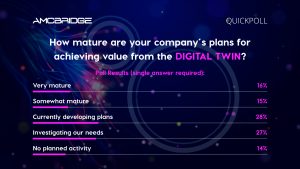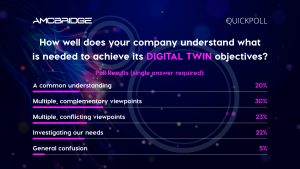What do clients really want from a digital twin? Igor Tsinman, co-founder and president of AMC Bridge, shares insights into the digital transformation of the AEC industry gained during a webinar organised by the company
Nowadays, a digital twin is considered a powerful toolset for modelling scenarios, identifying issues before they happen and making better decisions that improve the overall client experience. Still, many stakeholders cannot achieve its full potential and are stuck in their legacy methods and approaches on the route to adopt it. As a result, the value of a digital twin concept may be perceived differently depending on the environment.
When identifying how to add value to enterprise processes, workflows or workstreams, it is not enough to have a top-down digital twin strategy. It is crucial to understand that a starting point is to define user and business requirements in a standardised way and explore best practices in effective digital twin implementation.
To discuss the current state of digital twin adoption, technology and process gaps that companies face, and best practices that can be applied when pursuing a digital twin strategy, I was joined by the following industry experts in an AMC Bridge webinar: Jim Brown, founder and president of Tech-Clarity; Marzia Bolpagni, UK BIM Alliance ambassador; Rick Dunlap, technical services vice-president of BrandSafway; David Craig Weir-McCall, business development manager of Unreal Engine Enterprise for Epic Games; and Jim Quanci, senior director of ADN Partnerships at Autodesk.

What do companies really want from digital twins?
Currently, digital twins have become seen as the ultimate technology for many stakeholders to manage their connected infrastructure and assets efficiently and cost-effectively. Analysing the market, it is obvious that expectations for facilities and infrastructure management have become more sophisticated and, on the journey to digital twins, enterprises try to go to the next level with more complex IoT solutions compared to well-tried and familiar technologies. However, the industry is at the stage where the concept of a digital twin is a mixed bag of what stakeholders really want.
In my opinion, digital twins are something of a theoretical concept that allows us to think about the problem and, as a result, everybody understands it differently. However, in the end, people are looking for more efficiency, an improvement to the bottom line.
That is why sometimes the digital twin tagline can be a beacon that helps clients understand where they can get value from and gives them a direction of thinking of a digital twin as a powerful tool for modelling scenarios, identifying issues before they happen and being ready to proactively resolve them.
What are the requirements for an effective digital twin?
The implementation of an effective digital twin starts from data capture. However, it is not enough to gather data from the physical object and see what impact various changes to the manufacturing or construction process would have. It is critical to plan for and understand what is needed to manage, process, integrate, store and protect the data that enables digital twins. In other words, developing insights into operations of building assets and contextualising the collected information is one of the key values stakeholders are looking for to obtain a holistic, immersive understanding of the asset.
Based on the experience of AMC Bridge, it is a common case that the starting point for a digital twin project comes from visualisation. But the important point of it is being able to combine at least two or three sources of data and present a more enhanced, but not complete, picture of the real asset in the way you can measure the model, not only see it. This provides a more complete picture of what is going on in the physical world.
For the success of the project, it is crucial to identify standardised and clear requirements that will help adopt a practical digital twin concept. To make sure that it is built for the right use, every organisation should focus on an idea of the digital twin, choose the target application and understand the whole product concept behind it.

What does the poll say?
The results of the poll conducted during the webinar indicated that companies are still on their way to interpreting the value of a digital twin. Specifically, around 15% of the audience is very or somewhat mature in achieving value from the digital twin, while around 30% are still developing plans or investigating their needs for digital transformation. Only 14% of the respondents said they have no planned activities for digital twins.
Sharing how well they feel they understand what is needed to achieve digital twin objectives, the respondents confirmed that viewpoints are divided into complementary (30%) and conflicting (23%). Besides, 20% of respondents said they understand the main approaches to successfully implement a digital twin and 22% are still investigating their needs. The remaining 5% of the audience is confused about the matter.
Where are companies today in implementing a digital thread?
Right now, many companies are stuck in their methods to digitise their processes and create an effective digital ecosystem. One of the biggest disconnects is regarding the fact that one of the main values of digital twins is to build a consensus and follow it, involving other stakeholders, to end up with a single comprehensive source of truth.
Thus, only unified efforts will ensure a collaborative experience and create a sustainable background for a mature digital twin.
The full recording of the event is available at the following link.

Igor Tsinman
Co-founder and president
Tel: +1 866-575-4791






![[VIDEO] Making DorTrak reports easy to read with Fireco Inspecting fire doors at Fireco, firedoor technology, 2023](https://www.pbctoday.co.uk/news/wp-content/uploads/2024/04/JPZ_2364-web-218x150.jpg)
![[VIDEO] Re-flow Field Management review by Traffic Management Installations When TMI began subcontracting for councils and government bodies, they wanted to present their site reporting in a more professional manner](https://www.pbctoday.co.uk/news/wp-content/uploads/2025/03/TMI-Media-1-218x150.png)






